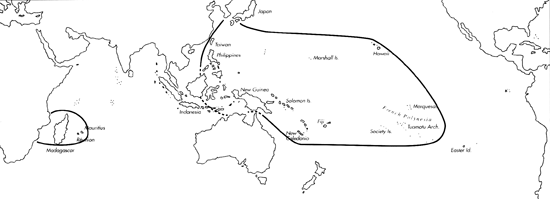Range: Central Indian Ocean to French Polynesia and Hawaii.
Description: Moderately small to medium-sized, light to moderately light. Last whorl narrowly ovate or ventricosely conical; outline convex. Shoulder indistinct. Spire high; outline convex. Larval shell of about 3.25 whorls, maximum diameter 0.7-0.8 mm. First 3-4 teleoconch whorls tuberculate. Teleoconch sutural ramps flat to slightly convex, with 1 distinct spiral groove in early whorls and 2-6 very weak grooves in later whorls. Last whorl glossy, almost smooth or with weak, finely granulose spiral ribs at base.
| Shell Morphometry | ||
|---|---|---|
| L | 25-49 mm | |
| RW | 0.04-0.05 g/mm | |
| (L 24-40 mm) | ||
| RD | 0.46-0.56 | |
| PMD | 0.67-0.80 | |
| RSH | 0.27-0.32 | |
Ground colour white. Last whorl with distinct, yellowish to dark brown axial flames, blotches and lines; one spiral ground colour band below shoulder and often another below centre, crossed by axial lines. Apex white. Later sutural ramps with brown radial blotches. Aperture white to bluish-white.
Periostracum light yellow, thin, translucent, smooth.
Habitat and Habits: In 1-25 m, in coral rubble and on sand under corals.
Discussion: C. cylindraceus closely resembles C. mitratus in size and shape. The latter species is distinguished by its less glossy and less smooth last whorl with granulose spiral ribs or spiral rows of granules and the stronger spiral ribs on its sutural ramps. The early postnuclear sutural ramps have 1 spiral groove in C. cylindraceus but 1 increasing to 2-3 grooves in C. mitratus.

C. cylindraceus range map
This section contains verbatim reproductions of the accounts of 316 species of Conus from the Indo-Pacific region, from Manual of the Living Conidae, by Röckel, Korn and Kohn (1995). They are reproduced with the kind permission of the present publisher, Conchbooks.
All plates and figures referred to in the text are also in Röckel, Korn & Kohn, 1995. Manual of the Living Conidae Vol. 1: Indo-Pacific Region.
The range maps have been modified so that each species account has it own map, rather than one map that showed the ranges of several species in the original work. This was necessary because each species account is on a separate page on the website and not confined to the order of accounts in the book.